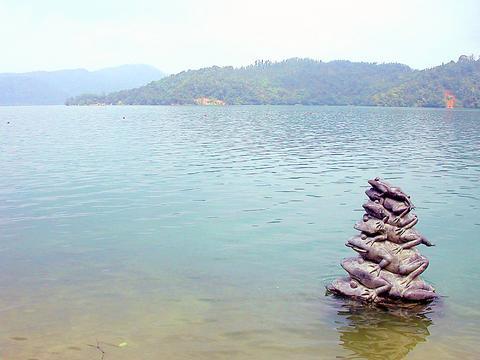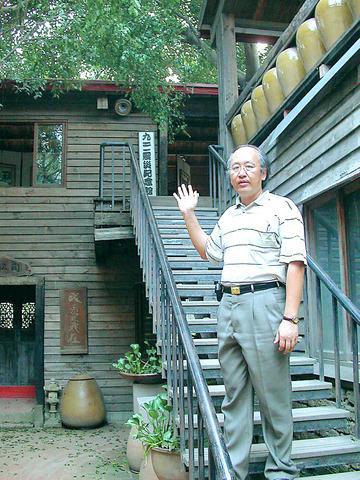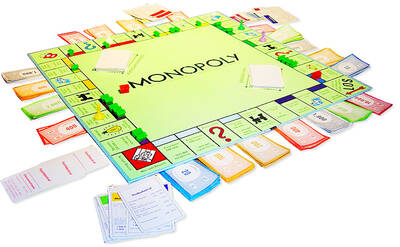Four years after the 921 earthquake, one of the most traumatic incidents in its history, Sun Moon Lake (
A record-breaking number of tourist visited the the lake in the past year, drawn to the new attractions set up after the quake.
Except for the few reconstruction sites of hotels razed in the quake, you won't even notice this vibrant tourist spot was defaced four years ago.

PHOTO: VICO LEE, TAIPEI TIMES
In the early morning of this day in 1999, an earthquake measuring 7.3 on the Richter scale shook the entire country. Its epicenter was 7.5km underground and 6.5km southwest of Sun Moon Lake. Over 2,300 people were killed and 39 went missing across Taiwan. Around Sun Moon Lake, large hotels crumbled. Wen Wu Temple (
Fortunately, Sun Moon Lake itself was undamaged and kept its former appearance and almost all facilities that were affected were restored by the end of last year, according to the Sun Moon Lake National Scenery Bureau. Four months after 921, the 1,900 hectare Sun Moon Lake Scenery Park was extended and it is now the 9,000 hectare Sun Moon Lake National Scenery Park. Administration for the park was transferred from the Nantou County Government to the Ministry of Transportation and Communication's Tourism Bureau.
When the Wen Wu Temple, the last lake-side reconstruction to be finished, reopens today, Sun Moon Lake will have won back all it has lost. Attractions set up after the earthquake, such as the eight lake-side foot-paths and bicycle tracks, add to the park's appeal.

PHOTO: VICO LEE, TAIPEI TIMES
A total of NT$1.368 billion has been poured into reconstruction in the past four years. "Work done in the past four years is much more than that done by the Nantou County Government in the 10 years before 921. The county government used to maintain what was already there, but since Sun Moon Lake became a national scenic area, there are new constructions we would never have expected before," said a life-long resident surnamed Huang. who lives in Shui-she (
In contrast with the many gloomy post-quake reports of Sun Moon Lake's future, residents now look back on the disaster in a more positive light. "In the quake, the worse hit was the hotels and Kuanghua Islet. The lake was what it was all along, just very beautiful," said Deng Hsiang-yang (鄧相揚), chief executive of the Sun Moon Lake Tourism Development Association, an organization of businesses in the area.
According to the Tourism Bureau, between 600,000 and 700,000 people visited the lake every year from 1998. In 1999, the year of the 921 earthquake, there were 630,000 visitors. The number dwindled to 310,000 in 2000, increased to 500,000 in 2001 and went back to the former level in last year, with 670,000 visitors. This year's numbers have already exceeded that, thanks to the first Sun Moon Lake International Fireworks Festival (日月潭國際水上花火嘉年華 ) and Sun Moon Lake Lake-Shore Music and Dance Festival (日月潭湖畔音樂舞蹈藝術節 ), which have brought in a daily average of 60,000 tourists. The Scenery Bureau expects the number of visitors to exceed 1 million this year.
Most hotel and tourist spot operators agreed that business has got back to normal, or is even better than normal this year. They attributed the improvement to the enlargement of the scenery park, now stretching from Yu-che (魚池) Township on the North, Shui-she (水社) on the East and Shui-li (水里) on the South to include Shui-li Snake Kiln (水里蛇窯 ), the Formosan Aboriginal Culture Village (九族文化村), Chi-chi Mountain (集集大山), Che-cheng's (車埕) and Da-kuan Power Plant (大觀電廠).
After tourism was affected by SARS from March through June, the Formosan Aboriginal Culture Village promoted tourism with a 50 percent discount, bringing in crowds of students in the summer vacation. Some of these have spread into the lake-side area.
"Tourist flows to Sun Moon Lake are very susceptible to influences. Promotion activities of any kind easily brings in tourists to other spots as well," Deng said.
Lin Su-chen (
"Many people are curious to see how Puli and Sun Moon Lake have changed after 921. All these tourists have to pass by my restaurant, so I was willing to invest the money," Lin said. "There's a saying that goes, `There is no great construction without severe destruction before it,' so the
disaster has its positive
consequences."
Lin Kuo-long (林國隆), owner of Shui-li Snake Kiln, one of the worst hit tourist spots, said the Sun Moon Lake area gained more from the earthquake than it had lost.
"The earthquake seriously affected business for roughly one year and after that it's been a series of national-level constructions and an increased budget, which will last a long time," Lin said. The kiln will soon see a new transportation hub built at its gate, which Lin expected to bring in more business.
Lin's optimism is backed up by the long history of the kiln, which had survived numerous typhoons, other earthquakes and SARS-induced recession.
"The earthquake of 921 was one of the various natural disasters the kiln has weathered. As long as the highway is working, people will come," Lin said.
Financial assistance from the government has also encouraged businesses to try new things. For instance, now Sun Moon Lake can boast one of the popular high-end holiday hotel/spa resorts, The Lalu (
The return of tourists has also brought back those who depend on them.
"If there's a major change in the Sun Moon Lake area this year, it's that tourists are back, and the hard-selling peddlers are back with them," resident Huang said.

Taiwan is one of the world’s greatest per-capita consumers of seafood. Whereas the average human is thought to eat around 20kg of seafood per year, each Taiwanese gets through 27kg to 35kg of ocean delicacies annually, depending on which source you find most credible. Given the ubiquity of dishes like oyster omelet (蚵仔煎) and milkfish soup (虱目魚湯), the higher estimate may well be correct. By global standards, let alone local consumption patterns, I’m not much of a seafood fan. It’s not just a matter of taste, although that’s part of it. What I’ve read about the environmental impact of the

It is jarring how differently Taiwan’s politics is portrayed in the international press compared to the local Chinese-language press. Viewed from abroad, Taiwan is seen as a geopolitical hotspot, or “The Most Dangerous Place on Earth,” as the Economist once blazoned across their cover. Meanwhile, tasked with facing down those existential threats, Taiwan’s leaders are dying their hair pink. These include former president Tsai Ing-wen (蔡英文), Vice President Hsiao Bi-khim (蕭美琴) and Kaohsiung Mayor Chen Chi-mai (陳其邁), among others. They are demonstrating what big fans they are of South Korean K-pop sensations Blackpink ahead of their concerts this weekend in Kaohsiung.

The captain of the giant Royal Navy battleship called his officers together to give them a first morsel of one of World War II’s most closely guarded secrets: Prepare yourselves, he said, for “an extremely important task.” “Speculations abound,” one of the officers wrote in his diary that day — June 2, 1944. “Some say a second front, some say we are to escort the Soviets, or doing something else around Iceland. No one is allowed ashore.” The secret was D-Day — the June 6, 1944, invasion of Nazi-occupied France with the world’s largest-ever sea, land and air armada. It punctured Adolf

The first Monopoly set I ever owned was the one everyone had — the classic edition with Mr Monopoly on the box. I bought it as a souvenir on holiday in my 30s. Twenty-five years later, I’ve got thousands of boxes stacked away in a warehouse, four Guinness World Records and have made several TV appearances. When Guinness visited my warehouse last year, they spent a whole day counting my collection. By the end, they confirmed I had 4,379 different sets. That was the fourth time I’d broken the record. There are many variants of Monopoly, and countries and businesses are constantly